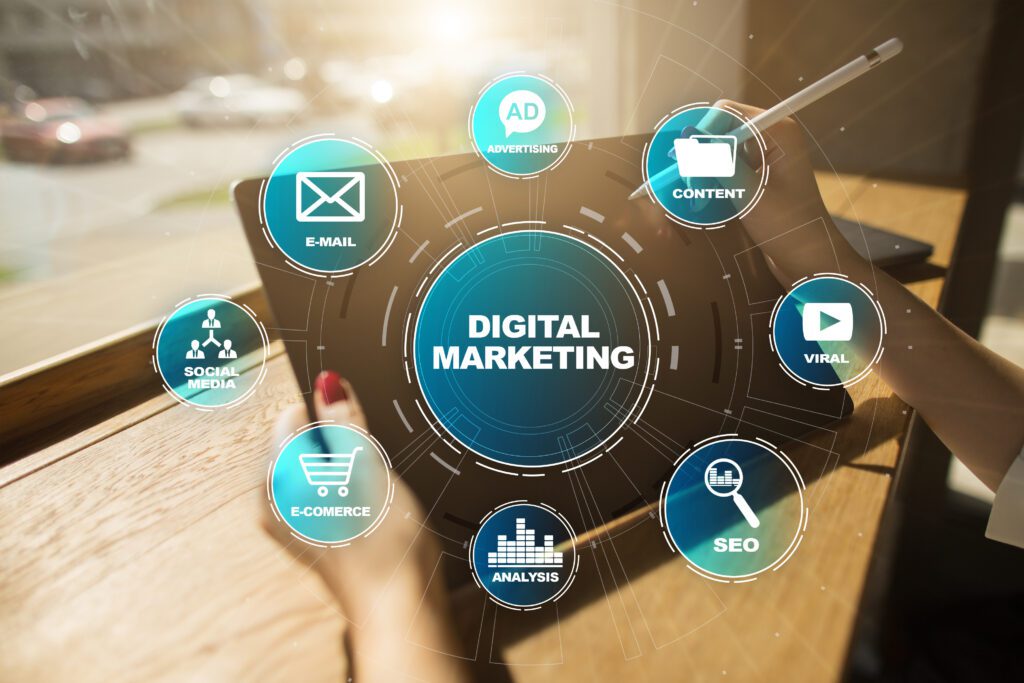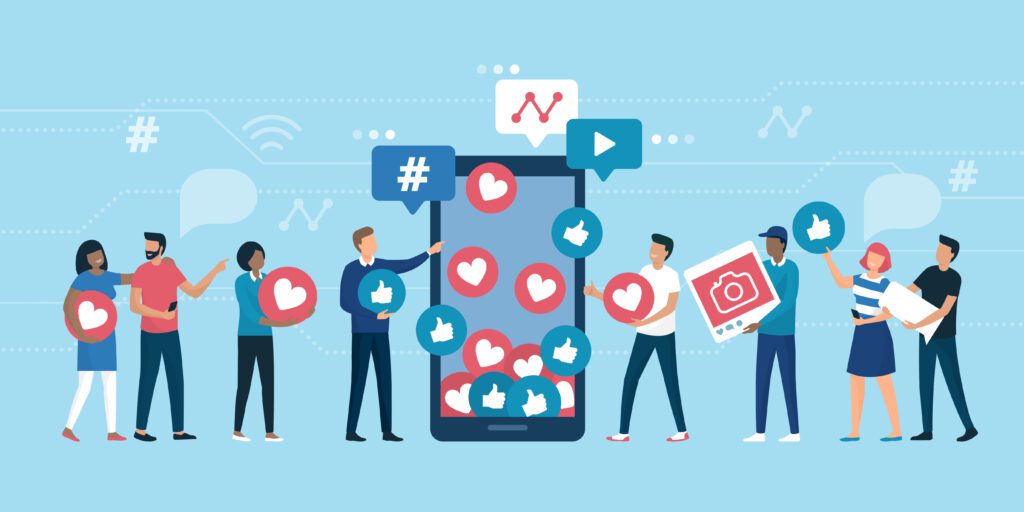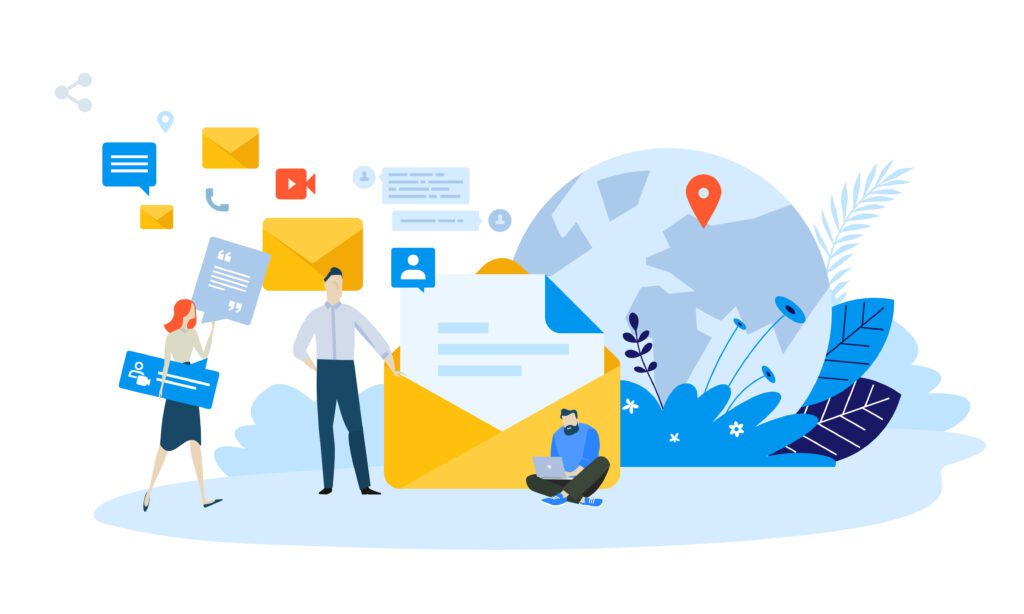Guide to Digital Marketing

- Digital Marketing: An Intro
- What Makes Digital Marketing Important?
- The History of Digital Marketing
- Online Digital Marketing at a Glance
- Search Engine Optimization (SEO)
- Search Engine Marketing (SEM)
- Content Marketing
- Social Media Marketing (SMM)
- Pay-per-click (PPC)
- Affiliate Marketing
- Email Marketing
- Enhanced Offline Marketing
- Radio Marketing
- TV Marketing
- Telemarketing
- Calling and Texting
- QR Codes
- Geofencing
- How to Set Up an Offline Digital Marketing Strategy
- FAQ
- Conclusion
Digital Marketing | An Intro
Digital media has transformed marketing in countless ways, from enabling targeted advertising to providing real-time feedback on campaign performance. Radio and television marketing are two classic forms of offline marketing that have also evolved with the digital age.
Radio marketing has been a staple of advertising for decades, but it has adapted to digital media by using sponsorships and partnerships with popular podcasts and online radio stations. These collaborations allow brands to reach new audiences in a more engaging and authentic way. Additionally, many radio stations now offer live streaming of their broadcasts, which can be accessed from anywhere in the world, expanding the potential reach of radio marketing efforts.
Television marketing, with its massive reach and ability to convey visual and auditory messages simultaneously, remains a popular medium for advertisers. However, like radio, it has also evolved with digital media. The rise of streaming services like Netflix and Hulu has disrupted traditional TV advertising, forcing advertisers to adapt to new platforms and audiences. Brands are now exploring opportunities for product placements and sponsorships within online TV shows and movies, as well as leveraging social media influencers to reach younger viewers.
Phone marketing, which includes SMS text messages and phone calls, is a form of offline marketing that has seen tremendous growth in recent years. While some early efforts, such as the controversial robocalls, have been met with backlash, brands are finding success with more personalized and targeted approaches. SMS text messages, in particular, have become a popular way to reach consumers, thanks to their high open and response rates. Marketers are using SMS to offer exclusive promotions, gather feedback, and even facilitate customer service.
In conclusion, while digital media has transformed marketing in countless ways, offline marketing channels like radio, television, and phone marketing remain relevant and effective. By adapting to new platforms and audiences, these classic forms of advertising can continue to play a valuable role in the marketing mix.
Digital marketing is a broad term that encompasses all marketing efforts that involve electronic devices and digital technologies. This type of marketing involves promoting products and services through a wide range of channels, including but not limited to social media platforms, search engines, email, mobile apps, and websites. Essentially, any marketing activity that uses electronic devices falls under the umbrella of digital marketing.
Digital marketing includes both online and offline tactics. Online tactics involve marketing through digital channels that are accessible via the internet, while offline tactics focus on marketing efforts that do not require an internet connection, such as radio and TV ads, billboard advertising, and SMS marketing.
Online tactics include social media marketing, search engine optimization (SEO), search engine marketing (SEM), content marketing, email marketing, affiliate marketing, influencer marketing, and mobile marketing, among others. Social media marketing involves using social media platforms to promote products and services, while SEO and SEM involve optimizing online content to rank higher on search engines like Google. Content marketing, on the other hand, involves creating and distributing valuable, relevant, and consistent content to attract and retain a clearly defined audience, and email marketing involves using email to promote products and services directly to customers.
Offline tactics, on the other hand, include radio and TV ads, billboard advertising, SMS marketing, and direct mail marketing. Radio and TV ads are still popular, despite the shift to online marketing, as they offer a way to reach a wider audience through traditional media. Billboard advertising is another popular offline tactic that uses large, eye-catching billboards to promote products and services in public spaces. SMS marketing involves sending promotional messages directly to customers’ phones, and direct mail marketing involves sending promotional materials directly to customers’ homes.
What makes Digital Marketing important?
The shift from traditional billboard advertising to online marketing is a clear indication of how the marketing landscape has changed. While billboard advertising may have been effective in the past, companies now realize the importance of being where their target audience is – online. Google and Facebook have been able to generate more revenue than any traditional media company due to the sheer number of users they have. With billions of users on these platforms, it’s no surprise that companies are shifting their focus towards digital marketing.
The key advantage of digital marketing is that it allows companies to reach a global audience with targeted messaging. With traditional media, it was difficult to target specific demographics, and it was often a one-size-fits-all approach. However, digital marketing has made it possible to target specific groups of people based on their interests, behaviors, and demographics. This level of targeting has made digital marketing more effective than traditional marketing methods.
Another key advantage of digital marketing is that it allows for real-time tracking and analysis of marketing efforts. Companies can track their marketing campaigns in real-time, which allows them to make changes on the fly and optimize their campaigns for maximum effectiveness. This is not possible with traditional marketing methods, which often require a significant investment of time and resources before any measurable results can be seen.
The shift towards digital marketing is not just a trend – it’s a necessity. Companies need to be where their target audience is, and today, that means being online. With the ability to reach a global audience, targeted messaging, and real-time tracking and analysis, digital marketing has become the most effective way for companies to connect with their customers and drive sales.
The reason why billboards, like the ones above, will die, is because the future of driving will look like this:

While driverless cars are already in existence, drivers are still required to remain attentive. However, as technology progresses, passengers will no longer need to focus on the road. Take a moment to observe your passenger the next time you offer someone a ride. They are likely to be using their phone. But if nobody is looking at the road, who will see those advertisements? Moreover, the proportion of people spending more time on electronic devices continues to increase while print advertising continues to decline. As a result, there isn’t much time left to learn digital marketing. Nearly 5 billion people worldwide utilize the internet for a range of activities such as shopping, learning, entertainment, and work. Digital marketing is critical to reaching these people. Even if you own a local store, you can’t overlook digital marketing. According to Google, 88 percent of individuals who search for a local business on their smartphone will visit a related store within the next week. By not being online, you’ll miss out on that traffic. Digital marketing also provides greater access to customer data and analytics, allowing you to better understand how they navigate the buying cycle and what they want. To ensure the success of your business, it is critical to understand and know how to leverage digital marketing.
The History of Digital Marketing
While digital marketing gained popularity in the early 2000s, it has been in existence for much longer. In fact, it has been around for about a hundred years longer. The first digital marketer in history was Guglielmo Marconi, and he was born in 1874. In 1896, he was the first human to demonstrate a “public transmission of wireless signals.” He invented the radio. Shortly after his demonstration in England, Morse signals were transmitted across open water. While it would take another 10 years for the radio to reach the general public, it sure didn’t take the creators long to realize they could use it to sell stuff. The first live broadcast was from an opera performance at the Met and guess what people did after it? They bought show tickets!
Digital marketing was born.
Guglielmo Marconi’s invention of the radio was just the beginning of digital marketing. In the 1920s, radio stations began airing sponsored content, which is similar to today’s radio sponsorships. The first radio ad was broadcasted on New York station WEAF in 1922 by Queensboro Corporation. The ad was for a real estate development in Queens, New York.
Television advertising also emerged in the 1940s, as television sets began to become more widespread in households. The first television ad was broadcasted in 1941, for a Bulova watch, before a baseball game between the Brooklyn Dodgers and Philadelphia Phillies. The ad lasted only nine seconds, but it marked the beginning of a new era in advertising.
As the internet became more popular in the 1990s, digital marketing began to take on a new form. The first banner ad was introduced in 1994 by AT&T, and soon after, search engines like Yahoo and Google began to sell ad space. With the rise of social media in the early 2000s, digital marketing continued to evolve and became more targeted and personalized.
Overall, while digital marketing may have taken on a new form with the advent of the internet, it has been around for much longer than most people realize. From radio and television ads to banner ads and social media campaigns, digital marketing has been used to sell products and services for over a century.
Online Digital Marketing at a Glance
Digital marketing is composed of two primary pillars: online marketing and offline marketing. However, since online marketing is the focus of a separate guide, I will only provide an overview of the different areas of online marketing here for completeness.
The seven major categories of online marketing are:
- Search engine optimization (SEO)
- Search engine marketing (SEM)
- Content marketing
- Social media marketing (SMM)
- Pay-per-click advertising (PPC)
- Affiliate marketing
- Email marketing
Search Engine Optimization (SEO)

Search Engine Optimization (SEO) is the process of optimizing a website or online content to increase its visibility and ranking in search engine results pages (SERPs) organically. The goal of SEO is to make a website more attractive to search engines and improve its chances of ranking higher in relevant searches, thereby driving more traffic to the site.
SEO involves a combination of technical and creative techniques, including optimizing website structure and content, improving website speed and performance, researching and incorporating relevant keywords and phrases, building high-quality backlinks, and ensuring mobile-friendliness and usability.
There are two main types of SEO: on-page optimization and off-page optimization. On-page optimization refers to optimizing individual pages on a website, including optimizing content, HTML tags, and internal linking. Off-page optimization refers to techniques used outside of the website to improve its ranking, such as building high-quality backlinks from other reputable websites.
SEO is an ongoing process that requires regular monitoring and adjustments as search engine algorithms and user behavior evolve over time. A successful SEO strategy can lead to increased visibility, traffic, and conversions for a website.
Search Engine Marketing (SEM)

Search Engine Marketing (SEM) is a digital marketing strategy that involves promoting a website or online content through paid advertising on search engines such as Google, Bing, or Yahoo. The primary goal of SEM is to increase website visibility and attract more traffic to a website by placing ads at the top of search engine results pages (SERPs) for relevant keywords and phrases.
SEM typically involves creating targeted ad campaigns that are triggered by specific search terms, also known as keywords. Advertisers bid on these keywords in a real-time auction system, with the highest bidder winning the top ad position for that keyword. Advertisers are only charged when a user clicks on their ad, hence the term “pay-per-click” (PPC) advertising.
SEM campaigns can be highly targeted, allowing advertisers to reach specific audiences based on factors such as demographics, location, and search behavior. Advertisers can also track and analyze the performance of their campaigns in real-time, making adjustments to optimize their results.
While SEM requires a financial investment, it can be a highly effective way to drive targeted traffic to a website quickly. However, to maximize the return on investment, it’s essential to have a well-designed landing page and a clear call-to-action to convert visitors into customers or leads.
Content Marketing

Content marketing is a strategic marketing approach that involves creating and distributing valuable, relevant, and consistent content to attract and engage a specific audience. The goal of content marketing is to build trust and establish authority with potential customers, ultimately driving profitable customer action, such as sales or leads.
Content marketing can take many forms, including blog posts, videos, social media posts, podcasts, infographics, e-books, whitepapers, and more. The key is to create content that is informative, entertaining, and helpful to the target audience. By providing value upfront, companies can build trust and establish a relationship with their audience, making them more likely to consider the company when they are ready to make a purchase or inquiry.
Content marketing involves a deliberate and ongoing effort to create high-quality content that is optimized for search engines and shared across relevant channels to maximize reach and engagement. It requires a deep understanding of the target audience’s needs, interests, and pain points, as well as a commitment to regularly creating and publishing new content.
Effective content marketing can help businesses increase brand awareness, generate leads, and drive conversions, all while building a loyal audience of engaged followers.
Social Media Marketing (SMM)

Social media marketing (SMM) is a type of digital marketing that involves using social media platforms to promote products, services, or content. The goal of social media marketing is to increase brand awareness, engage with customers, and drive traffic to a website or other online platform.
Social media marketing involves creating and sharing content on social media platforms such as Facebook, Twitter, Instagram, LinkedIn, and YouTube. The content can take many forms, including text, images, videos, and interactive elements such as polls and quizzes.
One of the main benefits of social media marketing is that it allows businesses to reach and engage with a large audience at a relatively low cost. Social media platforms also provide powerful targeting tools that allow businesses to target specific audiences based on factors such as demographics, interests, and behavior.
Social media marketing can also be used to build relationships with customers and foster brand loyalty. By engaging with customers through social media, businesses can build trust and establish a sense of community, ultimately leading to increased customer loyalty and repeat business.
To be successful in social media marketing, it’s important to have a clear strategy and consistent branding across all social media channels. Social media platforms require a commitment to regular posting and engagement, so it’s essential to have a plan in place to ensure that content is created and shared on a consistent basis.
Pay-per-click (PPC)

Pay-per-click (PPC) advertising is a digital advertising model in which advertisers pay each time a user clicks on one of their ads. PPC advertising is commonly used to drive traffic to websites, promote products or services, and increase brand awareness.
In a PPC advertising campaign, advertisers bid on keywords related to their business, industry, or target audience. When a user enters a search query containing those keywords, the search engine displays relevant ads in the sponsored results section of the search engine results page (SERP).
Advertisers are only charged when a user clicks on their ad, hence the term “pay-per-click”. The cost of each click depends on the bidding system, the competition for the keyword, and the quality of the ad and landing page. Advertisers can set a budget for their campaign, and once that budget is reached, the ads will no longer be displayed.
PPC advertising can be highly effective for businesses looking to drive targeted traffic to their website quickly. It allows businesses to target specific audiences based on factors such as location, demographics, and interests, and provides detailed analytics and tracking to measure the success of campaigns.
However, to be successful in PPC advertising, it’s essential to have a clear strategy, well-written ad copy, and a high-quality landing page that is optimized for conversions. Advertisers must also continuously monitor and adjust their campaigns to ensure that they are targeting the right keywords, bidding effectively, and maximizing their return on investment.
Affiliate Marketing

Affiliate marketing is a type of performance-based marketing in which a company partners with affiliates to promote its products or services. Affiliates are typically third-party publishers or individuals who promote the company’s products or services through their own websites, blogs, or social media channels.
Affiliates earn a commission for each sale or lead generated through their unique affiliate link or code. The commission structure can vary, but it is usually a percentage of the sale price or a fixed dollar amount per lead.
Affiliate marketing allows companies to reach a broader audience and increase sales without incurring the costs associated with traditional advertising. It also allows affiliates to earn a passive income by promoting products or services that align with their audience’s interests and needs.
To be successful in affiliate marketing, companies must have a clear affiliate program with well-defined terms and conditions, a competitive commission structure, and high-quality promotional materials such as banners, product images, and copy. Affiliates must also have a strong understanding of their audience and a strategy for promoting the products or services effectively.
Overall, affiliate marketing can be a highly effective way for companies to increase their reach and sales while providing affiliates with a lucrative income stream.
Email Marketing

Email marketing is a digital marketing strategy that involves sending commercial messages to a group of people via email. These messages can be promotional, informational, or educational and are typically sent to a list of subscribers who have opted-in to receive communications from the sender.
Email marketing is often used to build relationships with customers, increase brand awareness, promote products or services, and drive sales. The messages can take many forms, including newsletters, promotional emails, abandoned cart reminders, and transactional emails.
One of the main benefits of email marketing is that it allows businesses to communicate directly with their audience in a personalized and targeted way. Email marketing platforms provide powerful segmentation and automation tools that allow businesses to send targeted messages based on factors such as past purchases, website behavior, and interests.
Email marketing can also be highly cost-effective, with many email marketing platforms offering free or low-cost plans for small businesses. By creating and maintaining a list of subscribers who are interested in the company’s products or services, businesses can achieve a high return on investment (ROI) with minimal expense.
To be successful in email marketing, it’s essential to have a clear strategy and a strong understanding of the target audience. Emails should be well-written, visually appealing, and optimized for mobile devices. It’s also important to track and analyze the performance of email campaigns to identify areas for improvement and adjust the strategy accordingly.
Enhanced Offline Marketing

In the desert of Arizona, a billboard may differ from one in New York City’s Times Square by its size or the product advertised, but the most significant distinction is the three letters, LED, which stands for light-emitting diodes. Unlike traditional billboards, all the billboards in Times Square are electronic.
LED billboards have revolutionized outdoor advertising in recent years, allowing advertisers to create dynamic and eye-catching ads that can capture the attention of passersby. These digital displays use an array of LEDs to create vivid, high-resolution images and videos, making them ideal for locations with high foot traffic, such as Times Square.
The advantage of LED billboards is their flexibility and versatility. Advertisers can easily change the content of the ad to suit different promotions or events, and they can even incorporate real-time data, such as weather or traffic updates, to make the ad more relevant and engaging.
In addition to being more engaging, LED billboards are also more energy-efficient than traditional billboards. They use significantly less power and can run on renewable energy sources like solar power, making them a more sustainable option for outdoor advertising.
However, LED billboards are not without their challenges. Some have raised concerns about the potential for visual pollution, as the bright and flashy displays can be overwhelming in some contexts. Others have raised concerns about distracted driving, as drivers may be tempted to take their eyes off the road to look at the ads.
Overall, LED billboards have transformed outdoor advertising and offer advertisers a powerful tool to capture the attention of audiences in high-traffic areas like Times Square. However, it is important to use them responsibly and consider the potential impacts on the environment and public safety.
Radio Marketing
Radio marketing isn’t going away anytime soon. In fact, it’s thriving:
- Nearly 244 million Americans listen to the radio each month.
- People spend an average of 99 minutes per day listening to radio content.
- Radio ad spend is predicted to hit 11 billion USD. Radio marketing is a type of advertising strategy that uses the radio as a medium to reach a targeted audience. It involves creating and broadcasting ads on local or national radio stations to promote products, services, or events. Radio marketing can be an effective way to reach a large and diverse audience, as radio stations cater to a wide range of demographics and interests. It can also be a cost-effective option, as radio ads are generally less expensive to produce than other forms of advertising, such as television commercials. There are several types of radio ads that businesses can use for their marketing campaigns. These include live-read ads, which are read by the radio host or personality, pre-recorded ads that are played during commercial breaks, and sponsorships, where a business sponsors a particular segment of a radio program or event. One of the benefits of radio marketing is its ability to reach a captive audience. Unlike television or print ads, which can be easily ignored or skipped over, radio ads are often heard in the background while people are driving or doing other tasks. This means that businesses have the opportunity to capture listeners’ attention and create brand awareness. Radio marketing can also be targeted to specific demographics, depending on the station and time of day. For example, businesses targeting a younger audience may choose to advertise on a popular music station during the morning commute, while those targeting an older audience may choose to advertise during talk radio programs. Overall, radio marketing can be a valuable addition to a business’s advertising strategy, particularly for those looking to reach a large and diverse audience in a cost-effective manner.
Radio advertising has evolved over the years to become more effective in reaching audiences. One of the most popular ways that radio advertising has evolved is through the use of sponsorships. Sponsorships involve having the hosts of a radio show read out advertising messages at the beginning or end of the show.
The advantage of sponsorships is that they are less intrusive than traditional radio ads, as they are integrated into the programming and presented by the trusted voices of the hosts. This makes them more effective in capturing the listener’s attention and creating a positive brand association.
To create a sponsorship, businesses need to find the right radio station that caters to their target audience. Radio stations typically provide data on their audience demographics, such as age, gender, and location, which businesses can use to select the right station.
For example, a company selling maternity products can target a radio program whose average listener is a female between the ages of 24 and 40. This way, they can create a sponsorship that is specifically tailored to the interests of their target audience.
When creating a sponsorship, the key is to be entertaining and engaging. This means crafting a message that is informative, memorable, and relevant to the audience. Companies like Cadillac and Dairy Queen have created successful radio commercials by using creative storytelling and humor to capture the listener’s attention.
Overall, sponsorships are a smart way to advertise on radio and can help businesses reach their target audience in a more effective and engaging way. By working with the right radio station and creating a compelling message, businesses can increase brand awareness, generate leads, and ultimately drive sales.
TV Marketing
Television marketing is so huge, it’s unlikely to ever fully go away. However, it is changing as consumers move away from traditional television in favor of streaming services like Netflix and Amazon Prime.
Some fast facts about TV marketing:
- 122.4 million households in the US have a television.
- Cable providers lost 6 million subscribers a year between 2019 and 2021.
- 85 percent of US households have at least one streaming service.
Though cable TV ads are harder to target the right audience, have a low ROI compared to other forms of digital advertising, and generally seem irrelevant in the digital age, there is one type of television ad that may still be worth it; but it will cost you big. Remember I mentioned renting a billboard in Times Square can cost $50,000 a day? A 60-second commercial aired during the Super Bowl costs $5.6 million. The often viral and memorable commercials still pay for themselves thanks to their cross-pollinating effect. Roughly 10 percent of all TV commercial-related shares on social media come from Super Bowl ads. So do about 8 percent of all views on Youtube that go to TV commercial videos. If your commercial makes it to the blacklist (commercials the network decides can’t be shown on TV), the viral effect is usually even stronger, like the infamous Carl’s Junior ad that couldn’t be shown in the 2015 Super Bowl. What’s more, these commercials become online assets, generating millions of YouTube views over time. Sadly, the hype of the Super Bowl commercials is probably more of a remnant from a success period that’s about to fade. The $27 billion companies still annually spend worldwide on TV commercials may not always be the best investment moving forward. Television advertising, in the form we know it, is changing to make way for the more custom-tailored experiences we are already getting used to.
So, if you plan on doing offline digital marketing, I suggest focusing on a marketing platform or channel of the future—which in the case of television marketing, means streaming services.
Telemarketing

The prevalence of smartphones in the US is no secret, with about 75 percent of Americans owning one. As more people access the internet through their phones rather than desktop computers or laptops, it’s clear that mobile marketing is a critical strategy for businesses. Back in 2015, spending on mobile ads surpassed that of desktop ads for the first time, and the trend shows no signs of slowing down.
While mobile marketing encompasses a range of digital strategies, such as mobile apps, mobile websites, and mobile ads, there are also several offline methods businesses can use to market their products or services through phones. Here are some examples:
- Phone calls: While unsolicited cold calls can be intrusive and unwelcome, businesses can use phone calls to follow up with potential customers who have expressed interest in their products or services. This can be an effective way to answer questions, address concerns, and ultimately close a sale.
- Text message marketing: As previously mentioned, text message marketing can be an effective way to reach customers on their phones. Businesses can send text messages to customers who have opted-in to receive communications, offering promotions, discounts, or other exclusive deals.
- QR codes: QR codes are two-dimensional barcodes that can be scanned using a smartphone camera. Businesses can place QR codes on their marketing materials, such as posters, flyers, and business cards, to direct customers to a specific landing page or offer.
- Voice message marketing: Similar to text message marketing, businesses can use voice message marketing to leave a pre-recorded message for customers who have opted-in to receive communications. This can be a useful way to provide updates, offer promotions, or even provide customer service.
- App-based marketing: Many businesses have developed their own mobile apps to reach customers on their phones. These apps can offer exclusive deals, loyalty programs, and other incentives to keep customers engaged and coming back.
Overall, mobile marketing is a critical strategy for businesses looking to reach their target audience in today’s digital landscape. By leveraging the prevalence of smartphones and using a range of offline and online methods, businesses can connect with customers on their phones and drive sales.
Calling and Texting
While cold calling can generate sales, it can also be an intrusive and unwelcome interruption to people’s daily lives. This can result in a negative perception of the brand and ultimately damage the company’s reputation. On the other hand, text message marketing can be more effective as it allows businesses to reach their target audience in a non-intrusive way. Text messages are often read almost immediately after being received, making them an effective tool for promoting time-sensitive deals or limited-time offers.
Text message marketing is especially effective in the restaurant industry, where customers are often looking for the latest deals and discounts. Restaurants can use text messaging to send out promotions and deals to attract new customers and retain regulars. For example, a restaurant could offer a free appetizer or dessert for new customers who opt-in to receive text messages.
Text messaging can also be used as a customer service tool. Pharmacies, for example, can use text messaging to send prescription pickup reminders to their customers. This helps customers stay on top of their medications and reduces the risk of missed pickups.
A loyalty program that sends exclusive deals and giveaways to participating customers via text message is also an excellent way to keep customers engaged and coming back. Customers who feel valued and appreciated are more likely to become loyal customers who recommend the brand to their friends and family.
Overall, text message marketing can be an effective way to reach customers at scale, provided that businesses obtain permission and use the tactic appropriately. By offering value to customers in the form of promotions, customer service, and loyalty programs, businesses can use text messaging to build stronger relationships with their customers and increase sales.
QR Codes

QR codes, also known as Quick Response codes, have become a popular tool for businesses to engage with their customers through mobile marketing. QR codes can be easily scanned using a smartphone camera, directing users to a specific web page or app.
One of the benefits of QR codes is that they can be used for a variety of purposes in marketing. For example, businesses can use QR codes to deliver ads that direct users to a product page or promotion. QR codes can also be used to send users to a video or other multimedia content, such as a virtual tour or product demonstration.
QR codes can also be used in conjunction with other forms of enhanced offline marketing. For example, businesses can place QR codes on posters, flyers, or billboards to encourage users to engage with the brand online. This can be an effective way to bridge the gap between offline and online marketing, connecting with customers wherever they may be.
One of the advantages of QR codes is that they can be easily customized to fit a brand’s visual identity. Businesses can create custom QR codes that feature their logo or other brand elements, making them more visually appealing and recognizable to users.
Finally, the use of QR codes can also provide valuable data and insights into customer behavior. By tracking the usage of QR codes, businesses can gain insights into which campaigns are most effective, which products or services are generating the most interest, and how users are interacting with the brand.
Overall, QR codes are a versatile and effective tool for businesses to engage with their customers through mobile marketing. With their ease of use, customization options, and ability to provide valuable data, QR codes can be an excellent addition to any marketing strategy.
Geofencing
Geofencing is a technology that uses GPS, RFID, or Wi-Fi signals to create a virtual boundary or perimeter around a physical location, such as a store or event venue. When a mobile device enters or exits this boundary, it triggers an action, such as a push notification, an SMS message, or an advertisement.
In digital marketing, geofencing can be used to target consumers with highly personalized and contextually relevant messages based on their physical location. For example, a retailer can use geofencing to send promotional offers to customers when they are near the store, or a restaurant can send coupons to customers who are in the vicinity of their location.
Geofencing can also be used to track customer behavior and gather data on their movements and preferences. This data can be used to create more targeted and effective marketing campaigns.
Overall, geofencing is a powerful tool for digital marketers looking to engage customers in real-time and provide them with personalized, location-based experiences.
How to Set Up an Offline Digital Marketing Strategy
Looking to establish an offline digital marketing strategy? Follow these four simple steps:Enhance your offline marketing strategy by creating ads optimized for digital billboards, providing product demonstrations, and offering digital product samples.
- Develop a radio marketing strategy by reaching out to local radio stations for ad sponsorships, or creating engaging traditional ads that incorporate silly voices, local celebrities, or trending topics.
- Engage in television marketing by buying ad time during popular live events to achieve a decent ROI, creating ads that can go viral through being controversial, emotional, or humorous, or crafting ads that can be reused across multiple advertising channels.
- Utilize phone marketing techniques by taking advantage of the unique advertising opportunities presented by smartphones. This can include using modern software to make cold calls and leave ringless voicemails for targets, sending promotional texts to subscribing customers, or utilizing QR codes.
FAQ
What is digital marketing?
Digital marketing refers to advertising that is communicated through digital platforms such as social media, email, mobile apps, websites, search engines, web applications, and any emerging digital channels.
What's the future of digital marketing?
The offline and online worlds are colliding. Traditional devices such as fridges, ovens, and even billboards will all be modernized to leverage digital media.
Why does digital marketing matter?
Digital marketing is crucial because Google and Facebook attract a larger audience compared to traditional media companies. As a result, they generate more revenue. The reason behind this is that these platforms have a higher level of engagement, making them the center of attention, and hence, where businesses should focus their marketing efforts.
What channels make up digital marketing?
Search engines, social media, blogs, online ads, affiliate marketing, emails, and mobile apps.
How can I start a career in digital marketing?
Start by reading blogs, white papers, and other research to learn as much as you can. Then, consider taking a certification course in the field you want to work in.
Conclusion
This is what you need to know about digital marketing: Even in today’s world, the internet is not the only platform for marketers to succeed. Therefore, it is crucial for every marketer to master online marketing while not missing out on opportunities from offline tactics.
Incorporating these offline digital marketing techniques can diversify your lead generation beyond the traditional social media and content marketing approaches. Although our agency does not specialize in offline marketing, we can still help you in growing and establishing your online digital marketing strategy. Feel free to reach out to us for more information.


